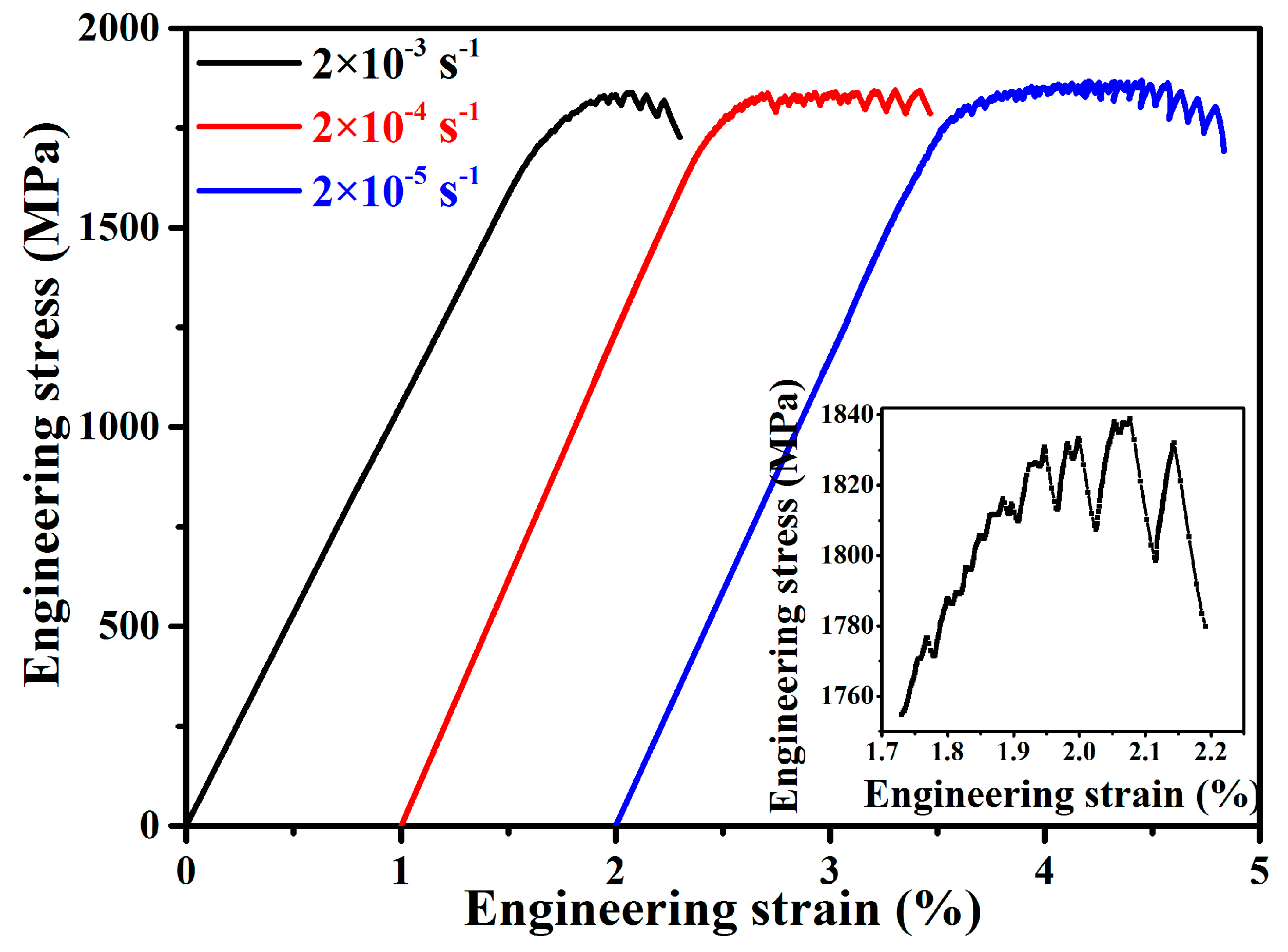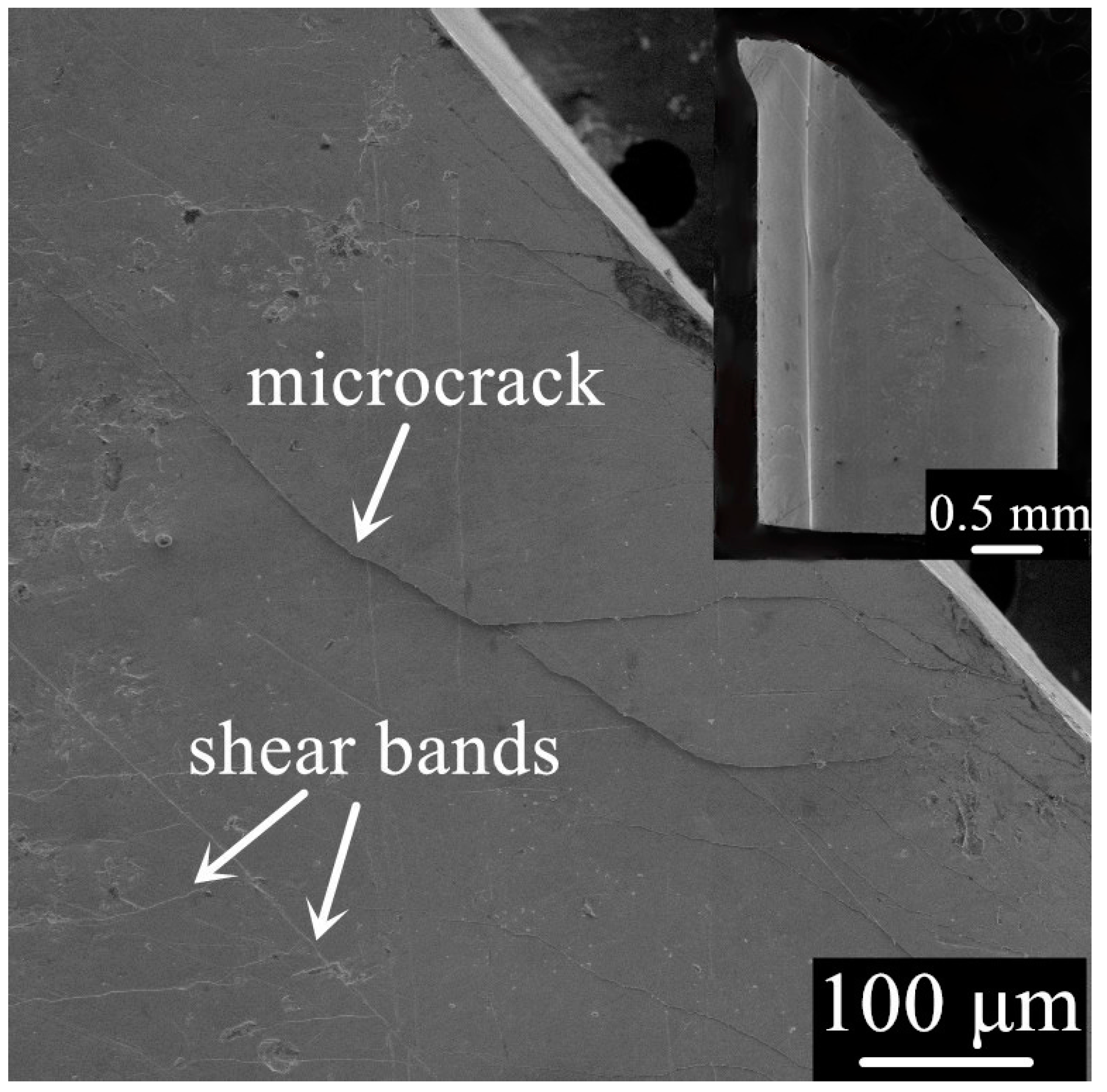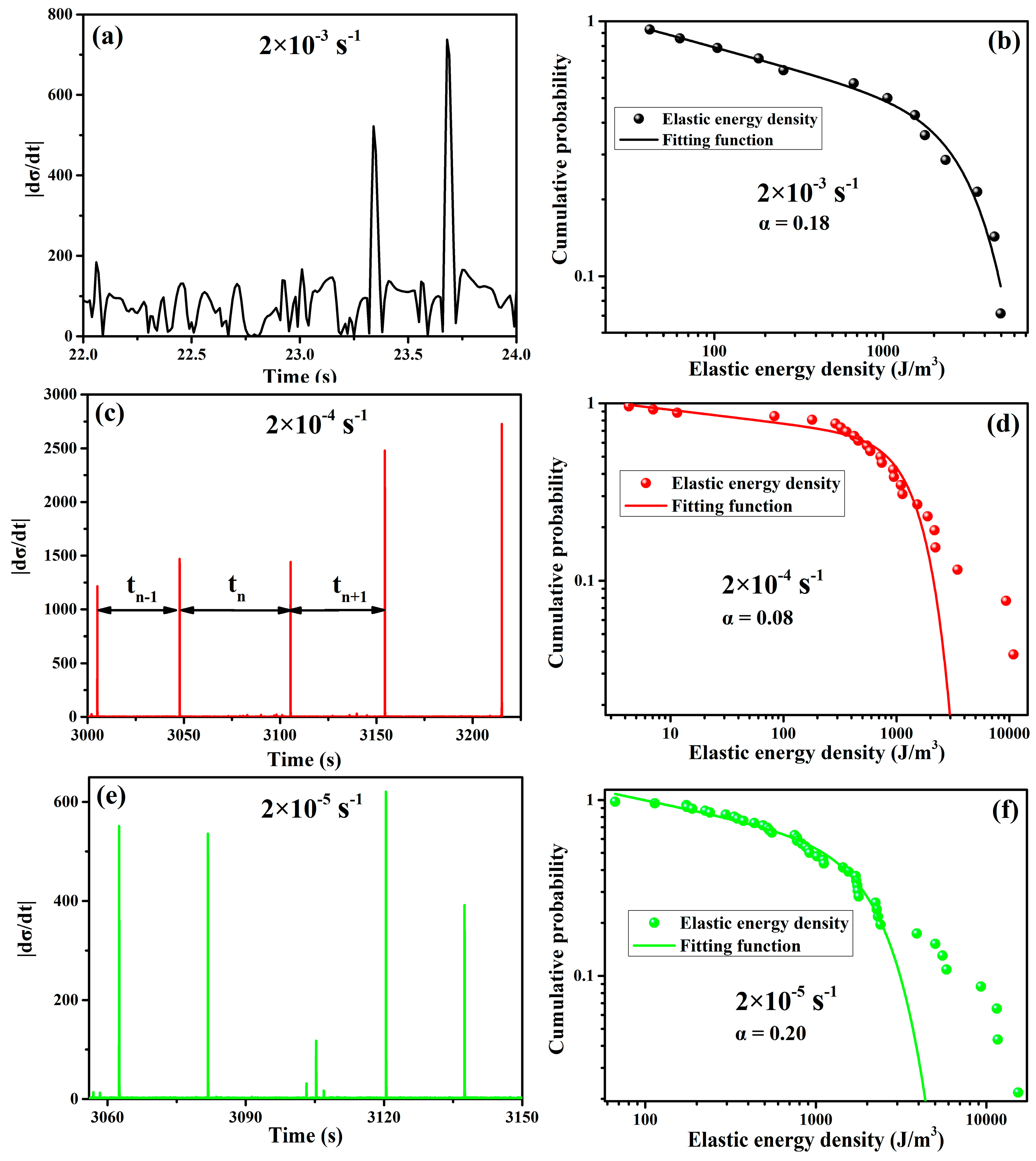Serration Behavior in Pd77.5Cu6Si16.5 Alloy
Abstract
:1. Introduction
2. Experimental Procedure
3. Results and Discussion
4. Conclusions
Acknowledgments
Author Contributions
Conflicts of Interest
References
- Zhang, Y.; Zuo, T.T.; Tang, Z.; Gao, M.C.; Dahmen, K.A.; Liaw, P.K.; Lu, Z.P. Microstructures and properties of high-entropy alloys. Prog. Mater. Sci. 2014, 61, 1–93. [Google Scholar] [CrossRef]
- Yeh, J.W.; Chen, S.K.; Lin, S.J.; Gan, J.Y.; Chin, T.S.; Shun, T.T.; Tsau, C.H.; Chang, S.Y. Nanostructured high-entropy alloys with multiple principal elements: Novel alloy design concepts and outcomes. Adv. Eng. Mater. 2004, 6, 299–303. [Google Scholar] [CrossRef]
- Zhang, Y.; Zhou, Y.J.; Lin, J.P.; Chen, G.L.; Liaw, P.K. Solid-solution phase formation rules for multi-component alloys. Adv. Eng. Mater. 2008, 10, 534–538. [Google Scholar] [CrossRef]
- Qiao, J.W.; Wang, Z.; Ren, L.W.; Jia, H.L.; Ma, S.G.; Yang, H.J.; Zhang, Y. Enhancement of mechanical and electrochemical properties of Al0.25CrCoFe1.25Ni1.25 high-entropy alloys by coating Ni–P amorphous films. Mater. Sci. Eng. A 2016, 657, 353–358. [Google Scholar] [CrossRef]
- Zhou, Y.; Zhang, Y.; Wang, Y.; Chen, G. Solid solution alloys of AlCoCrFeNiTix with excellent room-temperature mechanical properties. Appl. Phys. Lett. 2007, 90, 1904. [Google Scholar] [CrossRef]
- Zhao, Y.J.; Qiao, J.W.; Ma, S.G.; Gao, M.C.; Yang, H.J.; Chen, M.W.; Zhang, Y. A hexagonal close-packed high-entropy alloy: The effect of entropy. Mater. Des. 2016, 96, 10–15. [Google Scholar] [CrossRef]
- Gao, M.C.; Zhang, B.; Guo, S.M.; Qiao, J.W.; Hawk, J.A. High-entropy alloys in hexagonal close-packed structure. Metall. Mater. Trans. A 2016, 47, 3322–3332. [Google Scholar] [CrossRef]
- Gludovatz, B.; Hohenwarter, A.; Catoor, D.; Chang, E.H.; George, E.P.; Ritchie, R.O. A fracture-resistant high-entropy alloy for cryogenic applications. Science 2014, 345, 1153–1158. [Google Scholar] [CrossRef] [PubMed]
- Inoue, A.; Takeuchi, A. Recent development and application products of bulk glassy alloys. Acta Mater. 2011, 59, 2243–2267. [Google Scholar] [CrossRef]
- Wang, W.H. High-entropy metallic glasses. JOM 2014, 66, 2067–2077. [Google Scholar] [CrossRef]
- Takeuchi, A.; Gao, M.G.; Qiao, J.W.; Widom, M. Chapter 13 High-Entropy Metallic Glasses. In High Entroph Alloys: Fundamentals and Applications, 1st ed.; Gao, M.C., Yeh, J.W., Liaw, P.K., Zhang, Y., Eds.; Springer International Publishing: Cham, Switzerland, 2016. [Google Scholar]
- Chen, H.S.; Turnbull, D. Formation, stability and structure of palladium-silicon based alloy glasses. Acta Metall. 1969, 17, 1021–1031. [Google Scholar] [CrossRef]
- Chen, H.S.; Krause, J.T.; Coleman, E. Elastic constants, hardness and theri implications to flow properties of metallic glasses. J. Non Cryst. Sol. 1975, 18, 157–171. [Google Scholar] [CrossRef]
- Yao, K.F.; Yang, Y.Q.; Chen, N. Mechanical properties of Pd-Cu-Si bulk metallic glass. Intermetallics 2007, 15, 639–643. [Google Scholar] [CrossRef]
- Carroll, R.; Lee, C.; Tsai, C.W.; Yeh, J.W.; Antonaglia, J.; Brinkman, B.A.; LeBlanc, M.; Xie, X.; Chen, S.; Liaw, P.K.; Dahmen, K.A. Experiments and model for serration statistics in low-entropy, medium-entropy, and high-entropy alloys. Sci. Rep. 2015, 5, 16997. [Google Scholar] [CrossRef] [PubMed]
- Antonaglia, J.; Xie, X.; Tang, Z.; Tsai, C.W.; Qiao, J.W.; Zhang, Y.; Laktionova, M.O.; Tabachnikova, E.D.; Yeh, J.W.; Senkov, O.N.; et al. Temperature effects on deformation and serration behavior of high-entropy alloys (HEAs). JOM 2014, 66, 2002–2008. [Google Scholar] [CrossRef]
- Qiao, J.W.; Zhang, Y.; Liaw, P.K. Serrated flow kinetics in a Zr-based bulk metallic glass. Intermetallics 2010, 18, 2057–2064. [Google Scholar] [CrossRef]
- Friedman, N.; Jennings, A.T.; Tsekenis, G.; Kim, J.Y.; Tao, M.; Uhl, J.T.; Greer, J.R.; Dahmen, K.A. Statistics of dislocation slip avalanches in nanosized single crystals show tuned critical behavior predicted by a simple mean field model. Phys. Rev. Lett. 2012, 109, 095507. [Google Scholar] [CrossRef] [PubMed]
- Chihab, K.; Estrin, Y.; Kubin, L.P.; Vergnol, J. The kinetics of the Portevin-Le Chatelier bands in an Al-5at%Mg alloy. Scr. Metall. 1987, 21, 203–208. [Google Scholar] [CrossRef]
- Ananthakrishna, G. Current theoretical approaches to collective behavior of dislocations. Phys. Rep. 2007, 440, 113–259. [Google Scholar] [CrossRef]
- Klaumünzer, D.; Lazarev, A.; Maaß, R.; Dalla Torre, F.H.; Vinogradov, A.; Löffler, J.F. Probing shear-band initiation in metallic glasses. Phys. Rev. Lett. 2011, 107, 185502. [Google Scholar] [CrossRef] [PubMed]
- Dalla Torre, F.H.; Klaumünzer, D.; Maaß, R.; Löffler, J.F. Stick-slip behavior of serrated flow during inhomogeneous deformation of bulk metallic glasses. Acta Mater. 2010, 58, 3742–3750. [Google Scholar] [CrossRef]
- Qiao, J.W.; Yang, F.Q.; Wang, G.Y.; Liaw, P.K.; Zhang, Y. Jerky-flow characteristics for a Zr-based bulk metallic glass. Scr. Mater. 2010, 63, 1081–1084. [Google Scholar] [CrossRef]
- Song, S.X.; Bei, H.; Wadsworth, J.; Nieh, T.G. Flow serration in a Zr-based bulk metallic glass in compression at low strain rates. Intermetallics 2008, 16, 813–818. [Google Scholar] [CrossRef]
- Schuh, C.; Hufnagel, T.; Ramamurty, U. Mechanical behavior of amorphous alloys. Acta Mater. 2007, 55, 4067–4109. [Google Scholar] [CrossRef]
- Wang, G.; Chan, K.C.; Xia, L.; Yu, P.; Shen, J.; Wang, W.H. Self-organized intermittent plastic flow in bulk metallic glasses. Acta Mater. 2009, 57, 6146–6155. [Google Scholar] [CrossRef]
- Wang, Z.; Li, J.; Zhang, W.; Qiao, J.; Wang, B. The self-organized critical behavior in Pd-based bulk metallic glass. Metals 2015, 5, 1188–1196. [Google Scholar] [CrossRef]
- Greer, A.L. Metallic glasses. Science 1995, 267, 1947–1953. [Google Scholar] [CrossRef] [PubMed]
- Qiao, J.W.; Jia, H.L.; Liaw, P.K. Metallic glass matrix composites. Mater. Sci. Eng. R Rep. 2016, 100, 1–69. [Google Scholar] [CrossRef]
- Ren, J.L.; Chen, C.; Liu, Z.Y.; Li, R.; Wang, G. Plastic dynamics transition between chaotic and self-organized critical states in a glassy metal via a multifractal intermediate. Phys. Rev. B 2012, 86, 134303. [Google Scholar] [CrossRef]
- Yao, K.F.; Ruan, F.; Yang, Y.Q.; Chen, N. Superductile bulk metallic glass. Appl. Phys. Lett. 2006, 88, 122106. [Google Scholar] [CrossRef]
- Granata, D.; Fischer, E.; Wessels, V.; Löffler, J.F. Fluxing of Pd–Si–Cu bulk metallic glass and the role of cooling rate and purification. Acta Mater. 2014, 71, 145–152. [Google Scholar] [CrossRef]
- Qiao, J.W.; Wang, Z.; Jiao, Z.M.; Yang, H.J.; Ma, S.G.; Wang, Z.H.; Xu, B.S. Predicting burst sizes in amorphous alloys during plastic flows. Mater. Sci. Eng. A 2014, 609, 222–225. [Google Scholar] [CrossRef]
- Wang, Z.; Qiao, J.W.; Wang, G.; Dahmen, K.A.; Liaw, P.K.; Wang, Z.H.; Wang, B.C.; Xu, B.S. The mechanism of power-law scaling behavior by controlling shear bands in bulk metallic glass. Mater. Sci. Eng. A 2015, 639, 663–670. [Google Scholar] [CrossRef]
- Sun, B.A.; Wang, W.H. Fractal nature of multiple shear bands in severely deformed metallic glass. Appl. Phys. Lett. 2011, 98, 201902. [Google Scholar] [CrossRef]
- Qiao, J.W.; Jia, H.L.; Zhang, Y.; Liaw, P.K.; Li, L.F. Multi-step shear banding for bulk metallic glasses at ambient and cryogenic temperatures. Mater. Chem. Phys. 2012, 136, 75–79. [Google Scholar] [CrossRef]
- Ren, J.L.; Chen, C.; Wang, G.; Mattern, N.; Eckert, J. Dynamics of serrated flow in a bulk metallic glass. AIP Adv. 2011, 1, 032158. [Google Scholar] [CrossRef]
- Sarmah, R.; Ananthakrishna, G.; Sun, B.A.; Wang, W.H. Hidden order in serrated flow of metallic glasses. Acta Mater. 2011, 59, 4482–4493. [Google Scholar] [CrossRef]
- Song, S.X.; Wang, X.L.; Nieh, T.G. Capturing shear band propagation in a Zr-based metallic glass using a high-speed camera. Scr. Mater. 2010, 62, 847–850. [Google Scholar] [CrossRef]
- Csikor, F.F.; Motz, C.; Weygand, D.; Zaiser, M.; Zapperi, S. Dislocation avalanches, strain bursts, and the problem of plastic forming at the micrometer scale. Science 2007, 318, 251–254. [Google Scholar] [CrossRef] [PubMed]
- Bak, P.; Tang, C.; Wiesenfeld, K. Self-organized criticality: An explanation of the 1/f noise. Phys. Rev. Lett. 1987, 59, 381–384. [Google Scholar] [CrossRef] [PubMed]
- Koslowski, M.; LeSar, R.; Thomson, R. Avalanches and scaling in plastic deformation. Phys. Rev. Lett. 2004, 93, 125502. [Google Scholar] [CrossRef] [PubMed]
- Qiao, J.W.; Wang, Z. Self-organized Criticality Behavior in Bulk Metallic Glasses. J. Iron Steel Res. Int. 2016, 23, 7–13. [Google Scholar] [CrossRef]
- Bak, P.; Tang, C.; Wiesenfeld, K. Self-organized criticality. Phys. Rev. A 1988, 38, 364–374. [Google Scholar] [CrossRef]
- Sun, B.A.; Pauly, S.; Tan, J.; Stoica, M.; Wang, W.H.; Kühn, U.; Eckert, J. Serrated flow and stick–slip deformation dynamics in the presence of shear-band interactions for a Zr-based metallic glass. Acta Mater. 2012, 60, 4160–4171. [Google Scholar] [CrossRef]
- Yang, G.N.; Chen, S.Q.; Gu, J.L.; Zhao, S.F.; Li, J.F.; Shao, Y.; Wang, H.; Yao, K.F. Serration behaviours in metallic glasses with different plasticity. Philos. Mag. 2016, 96, 2243–2255. [Google Scholar] [CrossRef]




© 2016 by the authors; licensee MDPI, Basel, Switzerland. This article is an open access article distributed under the terms and conditions of the Creative Commons Attribution (CC-BY) license (http://creativecommons.org/licenses/by/4.0/).
Share and Cite
Wang, Z.; Li, J.; Yuan, B.; Wu, R.; Fan, J.; Wang, B. Serration Behavior in Pd77.5Cu6Si16.5 Alloy. Metals 2016, 6, 191. https://doi.org/10.3390/met6080191
Wang Z, Li J, Yuan B, Wu R, Fan J, Wang B. Serration Behavior in Pd77.5Cu6Si16.5 Alloy. Metals. 2016; 6(8):191. https://doi.org/10.3390/met6080191
Chicago/Turabian StyleWang, Zhong, Jiaojiao Li, Bo Yuan, Rongfeng Wu, Jing Fan, and Baocheng Wang. 2016. "Serration Behavior in Pd77.5Cu6Si16.5 Alloy" Metals 6, no. 8: 191. https://doi.org/10.3390/met6080191





